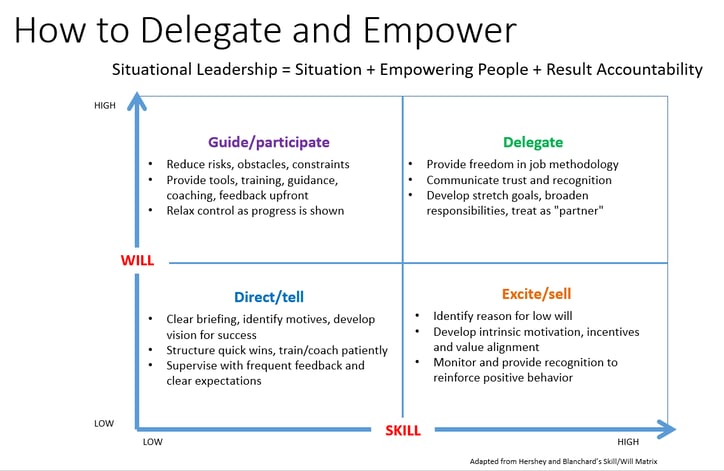One of the classic and most revered frameworks in all leadership development is the Hershey / Blanchard Skill Will Matrix. This framework presents leaders with a roadmap for how to effectively lead, delegate, and empower direct reports and others they need to influence based on the levels of Skill and Will the person has relative to performing in a job or task.
Blanchard Skill Will Matrix. This framework presents leaders with a roadmap for how to effectively lead, delegate, and empower direct reports and others they need to influence based on the levels of Skill and Will the person has relative to performing in a job or task.
As a facilitator of dynamic business simulation-centric leadership learning journeys, I have used and referenced this core framework thousands of times and shared with participants how and when to use each of the four quadrants as a situational leader.
Last week, during a live leadership training session, I was discussing the framework (on the screen behind me) while my participants were working on an exercise about delegation when it hit me; Skill and Will are not mutually exclusive!
For all of these years, like many leaders, I’ve had this bias that Skill and Will represent two distinct different directions and that the four quadrants are unique. They aren’t because of the concept too many leaders fail to recognize and that is the skill of Business Acumen.

I propose that Business Acumen is a driving function of both Skill and Will.
For example, if someone has strong Business Acumen skills, then I believe they will be more inclined and more comfortable executing a task and therefore will have a higher Will to do it.
In this perspective, I define Business Acumen as a skill set that understands how a company makes money through the execution of a value proposition supported by consistent operating decisions in Marketing, Sales, Finance, HR, R&D, Supply Chain, and Manufacturing. In other words, the person with strong Business Acumen skills has the capability to understand the big picture of how a company works, makes money, and the role the person plays in that system of business.
Below is a high-level analysis of how enhanced Business Acumen skills can positively impact each quadrant of the Skill – Will Matrix.
Low Skill – Low Will
The addition of Business Acumen skills can dramatically improve the performance of an employee who has low Skills and low Will. By increasing the skill set to understand the drivers of business performance, the employee will feel more confident. From a leadership perspective, we are taught that in this quadrant we need to be very specific and micro-manage this employee through the work process. But imagine the time and cost savings of not having to be to detail oriented and having to tell this employee what to do at every step of the process! Even a slight improvement of say 10% through the infusion of Business Acumen skills will provide the employee with more direction of how the work supports the execution of the strategy and lesson the burden on the manager.
Low Skill – High Will
The employee who falls into this quadrant can be impacted the most by the infusion of Business Acumen skills. This employee wants to succeed but doesn’t have the capabilities. While specific job function skills are also crucial, they are out of context as there isn’t the matching perspective of how the job and the decisions that are made and executed support the strategy, goals, and objectives of the business.
High Skill – Low Will
Inevitably, the employee who has high skills and low will is very strong in the technical aspects of the job but not the Business Acumen elements. Which means they really aren’t highly skilled but since most people don’t understand the value of Business Acumen we will let it go for now. Let’s just go with the belief that Business Acumen Skills will make the high skilled employee more skilled. I believe that adding the business acumen skills with make this person more confident and they will be able to see the bug picture better which will increase their energy and will. If that doesn’t work, then the person’s leader can try to excite them to be more motivated by using the power of business.
High Skill – High Will
This is the easiest quadrant of the matrix to improve performance and output in. By adding Business Acumen skills into a mix of high skills and high will, this employee can reach the highest level of optimized output possible and best of all, can do it without a lot of leadership supervision or focus.




